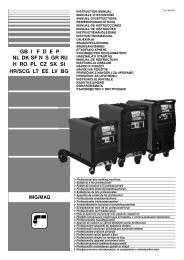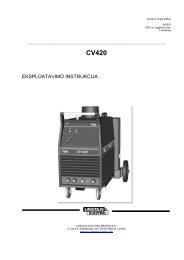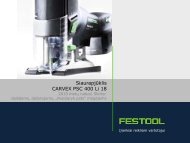MANUALE ISTRUZIONE - Jula
MANUALE ISTRUZIONE - Jula
MANUALE ISTRUZIONE - Jula
Create successful ePaper yourself
Turn your PDF publications into a flip-book with our unique Google optimized e-Paper software.
6- Compressed air circuit fault indicator (where provided). phase models have power supply cables that are to be connected to<br />
YELLOW LED (Fig. D2-6) at the same time as RED general alarm standard plugs, (2P+T) for single phase models and (3P+T) for 3-<br />
LED (Fig.D2-2 ).<br />
phase models, with appropriate capacities. Prepare a mains outlet<br />
When ON it means that the air pressure is insufficient for correct fitted with a fuse or an automatic circuit-breaker; the corresponding<br />
torch operation. During this event all machine operation will be earth terminal must be connected to the (yellow-green) earth<br />
disabled.<br />
conductor for the main power supply.<br />
Reset is automatic (the LED’s go off) when the pressure returns - Table 1 (TAB. 1) shows the recommended sizes for the delayed fuses<br />
within the allowed limits.<br />
on the power supply line, calculated according to the max. nominal<br />
7- Air button (where provided).<br />
output current of the machine, and to the rated power supply voltage.<br />
When this button is pressed, air will continue to be output from the ________________________________________________________<br />
torch for a fixed time.<br />
It is normally used: WARNING! Failure to comply with the above rules will render<br />
- for cooling the torch<br />
- when adjusting the pressure reading on the pressure gauge.<br />
the manufacturer’s (class I) safety system ineffective, with<br />
8- Pressure gauge.<br />
consequent serious risks to people (e.g. electric shock) and to<br />
Used to read the air pressure.<br />
property (e.g. fire).<br />
9- Torch connection connector.<br />
________________________________________________________<br />
Torch with direct or centralised connection.<br />
- The torch button is the only control device that can be used to CUTTING CIRCUIT CONNECTIONS<br />
control the start and end of cutting operations.<br />
________________________________________________________<br />
- When the button is released the cycle is instantly interrupted at any<br />
stage, while cooling air (post air) continues.<br />
WA R N I N G ! B E F O R E M A K I N G T H E F O L L OW I N G<br />
- Accidental operation: the cycle will only start if the button is CONNECTIONS MAKE SURE THAT THE POWER SOURCE HAS<br />
pressed and kept down for a minimum of some tenths of a second. BEEN SWITCHED OFF AND DISCONNECTED FROM THE MAIN<br />
- Electrical safeguard: button operation is disabled if the insulating POWER SUPPLY.<br />
nozzle holder has NOT been mounted on the head of the torch, or Table 1 (TAB. 1) shows the recommended values for the return cable (in<br />
if it has been mounted incorrectly.<br />
2<br />
mm ), based on the maximum current output from the machine.<br />
10- Earth cable connector ________________________________________________________<br />
5. INSTALLATION Compressed air hookup (FIG. G).<br />
________________________________________________________ - Prepare a compressed air distribution line with minimum pressure and<br />
capacity as given in table 2 (TAB. 2), for those models where it is<br />
WARNING! BEFORE CARRYING OUT INSTALLATION provided.<br />
OPERATIONS AND MAKING ELECTRICAL CONNECTIONS, IMPORTANT!<br />
ALWAYS MAKE SURE THAT THE PLASMA CUTTING SYSTEM HAS Do not exceed the maximum input pressure of 8 bar. Air containing<br />
BEEN SWITCHED OFF AND DISCONNECTED FROM THE MAIN substantial quantities of moisture or oil may cause excessive wear on the<br />
POWER SUPPLY.<br />
consumable parts or damage the torch. If the quality of the available<br />
ELECTRICAL CONNECTIONS MUST BE CARRIED OUT ONLY AND compressed air is doubtful, we recommend using an air dryer, to be fitted<br />
EXCLUSIVELY BY ESPERT OR SKILLED TECHNICIANS.<br />
upstream of the input filter. Use a flexible pipe to connect the compressed<br />
________________________________________________________ air supply to the machine, fitting one of the supplied connectors to the<br />
input air filter on the back of the machine.<br />
PREPARATION<br />
Unpack the machine, assemble the separate parts supplied with the<br />
Connecting the cutting current return cable.<br />
package.<br />
Connect the cutting current return cable to the piece to be cut or to the<br />
metal support bench, taking the following precautions:<br />
Assembling the return cable-earth clamp (Fig. E)<br />
- Make sure there is a good electrical contact, especially when cutting<br />
sheet that has an insulated coating or is oxidised etc.<br />
HOW TO LIFT THE MACHINE<br />
- Make the earth connection as close as possible to the cutting area.<br />
All the machines described in this manual must be lifted using the handle<br />
- Using metal structures that are not part of the workpiece as the cutting<br />
or the sling provided with the machine, if the model has one (fitted as<br />
current return conductor may endanger safety and result in an<br />
shown in FIG. F).<br />
inadequate cut.<br />
- Do not make the earth connection to the part of the piece that is to be<br />
POSITIONING THE MACHINE:<br />
cut away.<br />
The machine must be installed in a place where there are no obstructions<br />
Connecting the plasma cutting torch (FIG. H) (where provided).<br />
to the cooling air input and output apertures; at the same time, make sure<br />
that there is no possibility of conductive powder, corrosive vapour or<br />
Insert the male terminal of the torch into the centralised connector on the<br />
moisture etc. being sucked into the machine.<br />
front panel of the machine, matching the polarisation key. Tighten the<br />
Allow at least 250 mm of free space all around the machine.<br />
locking ring nut, clockwise as far as it will go, to ensure air and current<br />
passage with no leaks.<br />
________________________________________________________<br />
For some models the supplied torch is already connected to the power<br />
source.<br />
WARNING! Prevent the machine from tipping up or shifting IMPORTANT!<br />
dangerously, by positioning it on a level surface that is able to Before starting a cutting operation, make sure the consumable parts<br />
support its weight.<br />
have been fitted correctly by inspecting the head of the torch, as<br />
________________________________________________________ described in the chapter on "TORCH MAINTENANCE".<br />
CONNECTION TO THE MAIN POWER SUPPLY<br />
6. PLASMA CUTTING: DESCRIPTION OF THE PROCEDURE<br />
- Before making any electrical connection whatsoever, check the power The plasma arc and the application principle in plasma cutting.<br />
source rating plate to make sure that the mains voltage and frequency Plasma is a gas that is heated to an extremely high temperature and is<br />
correspond with those at the place where the machine is to be ionised so that it becomes an electrical conductor. This cutting procedure<br />
installed.<br />
uses the plasma to transfer the electric arc to the metal piece that is<br />
- The power source must be connected only and exclusively to a power melted by the heat and hence separated. The torch uses compressed air<br />
supply system with a neutral conductor connected to earth.<br />
form a single source, for both the plasma gas and the cooling and<br />
- In order to guarantee protection against indirect contact use RCD's of protection gas.<br />
the following types:<br />
HF strike<br />
This type of strike is normally used on models with currents of over 50A.<br />
- Type A ( ) for single phase machines; Cycle start is determined by a high frequency/high voltage (“HF”) arc that<br />
is used to strike a pilot arc between the electrode (-ve polarity) and the<br />
- Type B ( ) for 3-phase machines. torch nozzle (+ve polarity). When the torch is brought close to the piece to<br />
- In order to satisfy the requirements of Standard EN 61000-3-11 be cut, which is connected to the (+) polarity of the power source, the pilot<br />
(Flicker) we recommend connecting the power source to power supply arc is transferred to set up a plasma arc between the electrode (-) and the<br />
interface points with an impedance of less than the values shown in piece itself (the cutting arc): The pilot arc and HF strike are disabled as<br />
table 1 (TAB.1).<br />
soon as the plasma arc is established between the electrode and the<br />
- The plasma cutting system does not fall within the requisites of IEC/EN piece.<br />
61000-3-12 standard.<br />
Pilot arc hold time is set in the factory at 2 s; if there is no arc transfer<br />
Should it be connected to a public mains system, it is the installer's within this time the cycle is automatically stopped, apart from the<br />
responsibility to verify that the plasma cutting system itself is suitable continuance of cooling air.<br />
for connecting to it (if necessary, consult the distribution network To re-start the cycle it is necessary to release the torch button and then<br />
company)<br />
press it again.<br />
Shorting strike<br />
Plug and socket<br />
This type of strike is normally used on models with currents of less than<br />
- Single phase models with absorbed currents no greater than 16A are 50A.<br />
supplied with a power supply cable with a standard plug (2P+T) 16A Cycle start is determined by movement of the electrode inside the torch<br />
\250V.<br />
nozzle, which is used to strike a pilot arc between the electrode (-ve<br />
- Single phase model with absorbed currents greater than 16A and 3- polarity) and the nozzle itself (+ve polarity).<br />
- 6 -







